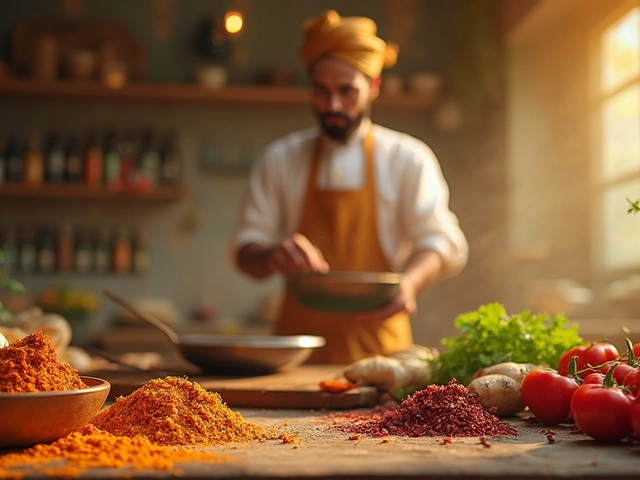So, you're curious about Ayurveda and eating meat? It's not as black and white as you might think. Ayurveda isn’t about strict rules but more about finding balance. It looks at the energies—Vata, Pitta, and Kapha—that make us unique.
Eating meat in Ayurveda is like figuring out where it fits in your puzzle. It's not about cutting it out completely unless that suits your body’s harmony. It considers your individual constitution, health situation, and even what time of year it is!
You might be surprised to know that, in certain cases, Ayurveda actually recommends meat. It’s not a free-for-all, though. There's guidance and context to when it's useful. Stick around to see how you can apply these principles one meal at a time to boost your health and well-being.
- Ayurveda's Take on Eating Meat
- Balancing Energies: Doshas and Diet
- When Meat is Recommended in Ayurveda
- Alternatives to Meat: Going Plant-Based
- Impact of Meat on Mind and Body
- Tips for Integrating Ayurveda into Your Diet
Ayurveda's Take on Eating Meat
In Ayurveda, food is more than just fuel; it's an integral part of maintaining balance and health. When it comes to meat, Ayurveda isn't strictly vegetarian but approaches it with thoughtfulness. It's all about the personal balance of energies—the doshas—that dictate whether meat might be helpful or not.
The unique thing about Ayurveda is that it focuses on individual constitution, called Prakriti. This means what works for one person might not work for another. Some may find meat helpful for boosting energy, especially those with a Vata or Pitta dosha imbalance where grounding and nourishment are needed.
Season and climate also play a role. During colder months, when the body's needs change, Ayurveda might suggest incorporating warming, strength-giving foods, like certain meats, to build strength and warmth. This isn't a green light for all-you-can-eat meat fest. Portion control and sourcing matter a lot. Opting for organic and ethically sourced meat aligns with Ayurvedic teachings of harmony and respect for life.
However, for those with strong Kapha energy or in need of detoxification, Ayurveda might recommend a lighter, plant-based approach. So, it's flexible but requires awareness and customization.
Ayurveda might be ancient, but its wisdom in using food as a tool for health is super relevant today. It encourages individuals to reflect on how meat affects their mind and body, promoting a harmonious lifestyle that acknowledges personal and environmental needs.
Balancing Energies: Doshas and Diet
Alright, so you've probably heard about these mystical doshas—Vata, Pitta, and Kapha. Ayurveda says we're all a mix of these energies, and keeping them balanced is key to good health. It’s kind of like maintaining your car: you don't want too much air in the tires or an empty gas tank.
If you’re wondering how these doshas relate to eating meat in Ayurveda, it’s pretty fascinating. Vata types, for instance, often benefit from warm, grounding foods. Pitta folks might need cooling foods to chill their natural heat. Kaphas, who have a more earthy energy, benefit from lighter, stimulating foods.
Here's something cool: Mark Halpern, a noted Ayurvedic expert, once said,
“Ayurvedic diet is not about deprivation; it’s about choosing foods that keep your doshas in harmony.”That means meat can be a part of a balanced diet if it helps maintain your energy harmony.
But how do you assess your dosha? You can seek a professional Ayurvedic practitioner, but there are also simple online quizzes to give you an idea. Knowing your dominant dosha can help you make informed dietary choices.
Ayurvedic diet even considers the seasons. In winter, Vata dosha is naturally more active, and warming foods—including some meats like chicken—can help maintain balance. During the heat of summer, Pitta types might avoid spicy meats to prevent overheating.
To wrap it up, think about your current states, like stress levels or digestion issues, which can affect your dosha balance. Your body sends signals, and Ayurveda helps decode them for better health.
When Meat is Recommended in Ayurveda
Surprised that Ayurveda sometimes says yes to meat? It’s all about balance and specific needs. Not everyone knows that this ancient wisdom suggests meat when there's a need to boost strength or aid recovery.
For folks with a Pitta or severe Vata imbalance, meat can help. Think of someone recovering from an illness or trauma—they might need the protein and grounding qualities meat offers. In such cases, Ayurveda sees it like a natural medicine.
Season and environment play a big role too. In really cold places or during winter, certain types of meat are recommended because they provide warmth and energy. It’s not just a free pass to feast; it comes with guidelines and moderation.
There’s also the concept of Rasa, or taste, which is key in Ayurveda. Different meats have different tastes and effects on digestion and energy. Ayurveda advises careful selection based on these principles.
If you're considering integrating meat based on Ayurvedic advice, remember this isn’t universal. It’s super personal, tailored to your body type and condition. Consulting a qualified Ayurvedic practitioner is crucial to get personalized guidance.

Alternatives to Meat: Going Plant-Based
Thinking about ditching meat and curious about plant-based options? Ayurveda offers loads of choices that won't make you miss meat at all. The key here is focusing on ingredients that complement your dosha while still giving you the nutrients you need.
First off, lentils, beans, and chickpeas are your best friends. They're packed with protein and, when combined with grains like rice or quinoa, form a complete protein that’s pretty similar to meat.
Don't overlook nuts and seeds. They not only add a crunchy texture to your dishes but are also rich in proteins and healthy fats. Almonds, walnuts, and chia seeds have diverse uses and can boost your meals.
Another cool option is tofu and tempeh. They get a lot of attention for being great meat substitutes, especially in curries and stir-fries. They absorb flavors well and can be prepared in various ways.
And then there's seitan, often called wheat meat. It’s another protein-rich alternative you can cook like chicken in many recipes. Just ensure you're not gluten-sensitive!
Ayurveda also encourages incorporating more vegetables and fruits into your meals. Leafy greens, colorful veggies, sweet potatoes, and berries not only diversify your diet but also bring in essential vitamins and fibers.
Check out this quick guide comparing nutritional values:
| Food | Protein (per 100g) | Calories |
|---|---|---|
| Lentils | 9g | 116 |
| Chickpeas | 19g | 164 |
| Tofu | 8g | 76 |
| Seitan | 25g | 120 |
Going plant-based doesn't mean missing out on essential nutrients. It’s all about balance and variety. Try blending different ingredients to find what works best for you energetically and nutritionally!
Impact of Meat on Mind and Body
Ever wonder how eating meat might play a role in your overall well-being according to Ayurveda? It’s more than just a physical experience—it's all about how it influences your mind and inner energy balance. Let’s break it down a bit.
Meat in Ayurveda is seen through the lens of how your body digests it and its effect on your mind. Some types of meat can generate extra heat, especially for those with a dominant Pitta dosha, leading to potential imbalances. But for Vata types, a little warmth and moisture from meat could be beneficial, grounding that airy, light energy.
Notably, the way meat is processed and consumed is key. Heavy, oily preparations might bog down your digestive fire, called Agni in Ayurveda, causing sluggishness, both physically and mentally. This can make us feel lethargic or even heighten irritability. On the other hand, fresh, well-cooked and lightly seasoned meat in the right proportions can support strength and vitality.
Let’s not forget the emotional aspects. Eating meat sometimes gives a sense of connection to nature's cycle of life and nourishment, if done mindfully and with respect. However, overconsumption might make some feel disconnected or burdened.
To put it simply, how meat impacts you depends much on your unique constitution, health needs, and even your mindset. Balance is the mantra, alongside understanding when and how to incorporate meat harmoniously into your diet.
So, thinking of how to fit meat into your ayurvedic lifestyle? Consider how certain meats might fit or disrupt your flow, both physically and mentally. And remember, in Ayurveda, it’s crucial to listen to your body's signals and adjust accordingly—eat what feels nourishing, not just filling.
Tips for Integrating Ayurveda into Your Diet
Jumping into an Ayurvedic lifestyle might seem daunting at first, but it’s simpler than you think. Start by understanding your body type, or dosha. Knowing whether you’re Vata, Pitta, or Kapha helps guide what you eat.
Next, keep your meals planned around seasonal foods. Nature has a way of tailoring food to our needs based on the time of year. For instance, cooling foods like cucumbers and melons are great during summer when Pitta (associated with heat) is dominant.
Let’s talk about how we eat, not just what we eat. Ayurveda suggests eating in a calm environment, free from distractions like TV or smartphones. Focus on enjoying your meal to aid digestion.
When it comes to cooking, use spices like cumin, turmeric, and ginger. These don’t just add flavor—they boost digestion and balance the Ayurvedic doshas. Turmeric, for example, is known for its anti-inflammatory properties.
- Dosha-based meals: If you’re Vata, opt for warm, oily foods. Pitta individuals should avoid spicy and excess oily foods. Kaphas benefit from light, dry meals.
- Mindful eating: Chew your food well before swallowing. It sounds basic, but this step is key for proper digestion.
And for the lazy cooker, make sure to stick to simple meals. Ayurveda doesn’t need fancy, complex recipes. A simple lentil dish packed with seasonal veggies and a blend of your favorite spices can be wholly satisfying and nutritious.
Did you know that including fermented foods like yogurt can help you if a Kapha dosha tends to slow down your digestion? These foods can stimulate your digestive fire, improving nutrient absorption and overall health.
Integrating Ayurveda into your daily diet is about gradual changes. Don't stress about doing everything all at once. Instead, take it one meal at a time, and soon, these habits will become second nature.








